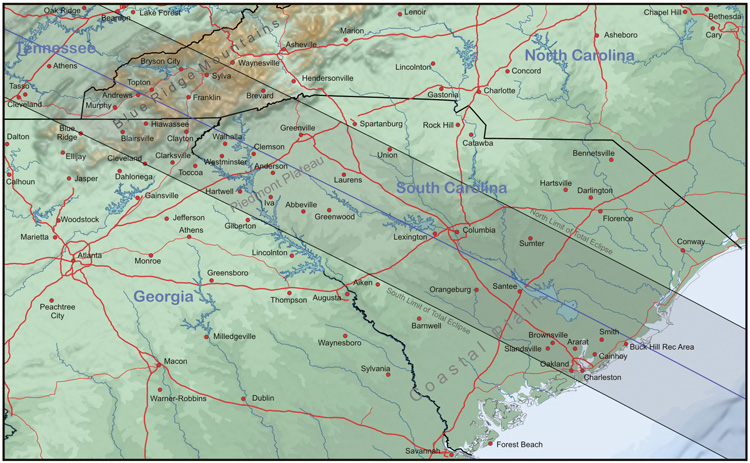Those interested in astronomy or rare events in the skies overhead are preparing for the total solar eclipse that will be visible locally on Monday, Aug. 21 and over large portions of the United States.
NASA reported that the eclipse — although not a totality event this far south — will be visible from Fayette and Coweta counties beginning shortly after 1 p.m., with maximum darkness occurring at approximately 2:36 p.m. and ending at 4:01 p.m.
Above, map of eclipse path across three southern states. Source/Eclipsophile.
Beginning on the west coast in Oregon, the totality can be witnessed completely in a 67-mile wide band that includes Nashville, Tenn., Clayton in north Georgia, Columbia, S.C., and Charleston before heading out to sea, said Flint River Astronomy Club Vice President Bill Warren.
From the local area, less than 10 percent of the sun’s light will remain visible throughout the eclipse, but that is enough to be harmful to your eyes if you are not careful, said Warren.
“This will be the first total solar eclipse to be visible as a partial eclipse in all 48 continental states since 1979, said Warren. “More importantly, total eclipses are rare. The chances of (Fayette and Coweta counties), or any specific location in the U.S. lying in the path of totality are one in every 330 years.”
Totality in this area or not, Warren said it is important to wear solar sunglasses or use a solar filter on a telescope while any part of the sun is visible.
“Specially-made solar sunglasses are completely safe. Unlike ordinary sunglasses, they block out all of the sun’s harmful rays. You can buy them on the web by Googling ‘solar sunglasses,’” said Warren, then emphasizing, “Do not look at the exposed sun for prolonged periods unless you are wearing solar sunglasses.”
An alternative way to view the eclipse is by using a pane of No.14 welder’s glass for approximately $25, Warren said, adding that welder’s glass other than No. 14 is not safe for viewing an eclipse.
Still another method of viewing the eclipse, and the one that is the simplest, cheapest and safest of all, is a pinhole projection.
“Lay an index card on the ground, then use a pencil point to punch a hole in a second index card. Hold the second card about 3-4 feet above the one on the ground and align it with the sun. Don’t look at the sun while you’re doing that,” said Warren. “The eclipsed sun will project through the hole onto the card on the ground. The larger you make the hole, the larger the sun will appear.”
According to NASA, “This celestial event is a solar eclipse in which the moon passes between the sun and earth and blocks all or part of the sun for up to about three hours, from beginning to end, as viewed from a given location. For this eclipse, the longest period when the moon completely blocks the sun from any given location along the path will be about two minutes and 40 seconds. The last time the contiguous U.S. saw a total eclipse was in 1979.”
For recommendations on viewing the eclipse safely visit https://eclipse2017.nasa.gov/safety.
Also getting in on the eclipse action is the National Weather Service. Chief meteorologist Keith Stellman at the Peachtree City headquarters said NWS will soon include eclipse information on its webpage, www.weather.gov/atlanta, and on Facebook and Twitter. He said NWS will feature a new eclipse topic every week.
Meanwhile, Georgia’s state parks are gearing up for the biggest stellar show that most of us will ever see. The “path of totality” – where day will briefly turn to night – includes northeast Georgia State Parks such as Black Rock Mountain and Tallulah Gorge. Park officials are making plans for what may be the biggest crowds since 30,000 people watched tightrope aerialist Karl Wallenda cross the gorge in 1970.
Cabins and campsites at state parks within the path have been sold out for months, and parks within two hour’s drive are quickly filling up. To help amateur astronomers find places to stay, Georgia’s State Parks are posting the best locations and availability on www.GaStateParks.org/Eclipse2017. Don Carter State Park on Lake Lanier, Victoria Bryant State Park near Royston and Watson Mill Bridge State Park near Athens are just some of the parks that are within a short drive of the eclipse path.
The park system’s website also includes a calendar of viewing celebrations and eclipse facts. State park gift shops are already stocking up on viewing glasses and souvenir T-shirts. Elijah Clark State Park has planned a guided trip on Clarks Hill Lake to enjoy the sudden darkness from a kayak. Vogel State Park in Blairsville will host a celebration with children’s crafts. Even sites as far as Fort King George on Georgia’s coast have planned events since their visitors will see a partial solar eclipse.
Park managers are reminding visitors to use only official park entrances, with most opening at 7 a.m., and that a $5 ParkPass is required for all vehicles. If parks reach capacity, entrance gates may need to close. Everyone staying overnight will need a reservation. Overnight parking, hiking off trails and alcohol are not allowed. To learn more about solar eclipse celebrations in Georgia’s State Parks, visit www.GaStateParks.org/Eclipse2017.











Leave a Comment
You must be logged in to post a comment.